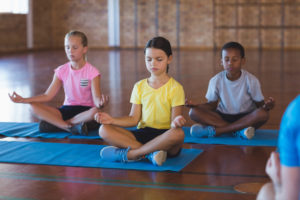Mindfulness and ADHD: 4 Relaxation Games for Children

Yoga is a natural stress-reducer, a kind of meditation in practice. While many adults use yoga for improvement of physical and mental health, it is also an exceptional outlet for children.
Research has shown that mindfulness-based treatments may be effective for a range of mental and physical health disorders in adults. It turns out that the slow, focused and calming aspects of mindfulness meditation have similar results for children with ADHD, who are often impulsive, unfocused, hyperactive, and fidgety.
I use mindfulness-based meditation in my work with children diagnosed with ADHD. When the meditation is used in conjunction with play or talk therapy, the results are extremely positive. Many of the children are able to slow their thoughts and impulses, and are more aware of their actions both in the home and during school. There are 4 simple mindfulness games that you can easily play with your children at home. You might even try them yourself – it's good for the whole family!
- One: Breathing Practice
Begin by picking out a favorite stuffed animal for each participant. While lying on the floor with your child(ren), place one stuffed animal on each person's stomach. Direct everyone to take deep, slow breaths, while watching the movement of the stuffed animal. After a bit, talk about what you notice the animal doing. Your child will naturally learn to self-sooth and calm hyperactive behaviors. - Two: Sitting Meditation
Pick a time, maybe before a meal or during the wind-down time before bed, and tell your child you are going to play a relaxing game. Pull up two chairs, or use the child's bed. Ask your child to sit with his or her feet flat on the floor, back straight, and hands on his/her knees. Using a gentle, slow voice, start saying something like:“Choose a spot on the wall to focus. Keep your feet flat on the floor and your hands on your knees. Breathe in nice and slow, hold it, and let it out nice and slow. When you feel your feet or your fingers getting wiggly, just say in your head ‘it's okay that you're feeling wiggly, but right now we have to be very still.' Pretend you're a statue and all you can do is focus on your breath. Pretend your hands are glued to your knees. Feel every single finger heavy and tight to your pants. Everything is feeling very heavy and still. Whenever you feel wiggly, think about where you're feeling it and in your head tell that body part that it's okay, but right now you're going to be very still.”Do this for only a minute or two the first time, and expand by one to two minutes each subsequent session. Do not exceed your child's age in the number of minutes you spend.
- Three: Walking Meditation
In Buddhist walking meditation, mindfulness comes while walking and trying to keep awareness on the experience of walking. In a similar manner, you can help your child become more aware of his or her body through walking, inside or out. Tell your child you are going to play a walking game. Begin walking together, very slowly, step by step. I often give instruction while we walk which sound something like this: “Take a very slow step forward. Feel the way your knee bends and the way your foot feels when it touches the floor. When you feel yourself wanting to go faster, or go in a crooked line, just say in your head ‘I'm getting tired of walking slow and straight but I'm going to keep on doing it.' Make sure you breathe nice and slow. Pay attention to the way it makes your body feel to go slowly after going fast all day.” You can talk to you child about how he or she can use this skill at school in the halls, walking slowly and being more conscious of walking. - Four: Freeze Game
In the final game, turn on music and have your child dance or be silly in the room. After a couple of minutes, shout out “freeze!” Instruct your child to freeze and remain perfectly still. During the period of stillness, give the following assertion: “Notice how different your body feels standing perfectly still than it did when it was dancing. Try to stay very still in the position you're stuck in. Notice if one part of your body wants to move or is getting tired. Instead of moving that body part, breathe deep and slowly and tell yourself ‘it's okay that you're tired or want to wiggle, but for now you're going to stay nice and still.'” The freeze lasts a minute or so and then the music resumes. The process re-starts and the freezing gets longer each time.
As a parent, these games provide a nice way to bond with your children through relaxed meditation practices before bed, in the afternoon, or on days out of school. The use of mindfulness-based meditation with children, and especially with children diagnosed with ADHD, can be therapeutic AND fun, a great combination to enjoy home life with your child.

